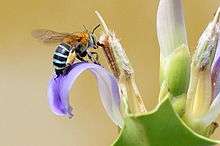Amegilla
Amegilla is a large genus of bees in the tribe Anthophorini. Several species have blue metallic bands on the abdomen, and are referred to as "blue-banded bees". The genus occurs all around the world but very few live above 45° North.[1]
| Amegilla | |
|---|---|
 | |
| A. cingulata | |
| Scientific classification | |
| Kingdom: | Animalia |
| Phylum: | Arthropoda |
| Class: | Insecta |
| Order: | Hymenoptera |
| Family: | Apidae |
| Tribe: | Anthophorini |
| Genus: | Amegilla Friese, 1897 |
| Species | |
|
See text. | |
| Diversity | |
| c. 260 species | |
Selected species
- Amegilla bombiformis (Smith, 1854)
- Amegilla calens (Lepeletier, 1841)
- Amegilla canifrons (Smith, 1854)
- Amegilla confusa (Smith, 1854)
- Amegilla dawsoni (Rayment, 1951)
- Amegilla quadrifasciata (Villers, 1789)
- Amegilla violacea (Lepeletier, 1841)
- Amegilla mucorea (Klug, 1845)
- Amegilla fallax (Smith, 1879)
- Amegilla subcoerulea (Lepeletier, 1841)
- Amegilla cingulata (Fabricius, 1775)
- Amegilla cingulifera (Cockerell, 1910)
- Amegilla comberi (Cockerell, 1911)
- Amegilla niveocincta (Smith, 1854)
- Amegilla perasserta (Rayment, 1947)
- Amegilla puttalama (Strand, 1913)
- Amegilla subinsularis (Strand) Cockerell, 1919
- Amegilla zonata (Linnaeus, 1758)
gollark: Basically, send one query to get a session token of some sort, and then repeatedly send queries involving that to get the remaining data. But DNS doesn't guarantee message ordering, obviously, so you need to have sequence numbers and reassemble somewhere and ask for retransmits and all that.
gollark: It would be *especially* annoying to get good performance, but I guess you could just not.
gollark: I know roughly how. It would just be annoying to implement.
gollark: No, this is actually hard.
gollark: Well, moderately easily.
See also
- Josephine Cardale, an Amegilla researcher
References

- ITIS: Genus Amegilla
- "Atlas Hymenoptera". www.atlashymenoptera.net. Retrieved 22 May 2020.
| Wikimedia Commons has media related to Amegilla. |
This article is issued from Wikipedia. The text is licensed under Creative Commons - Attribution - Sharealike. Additional terms may apply for the media files.